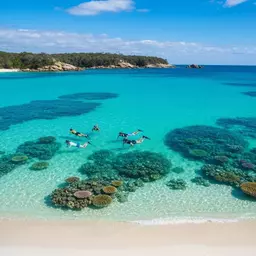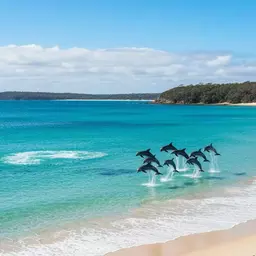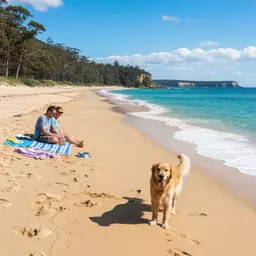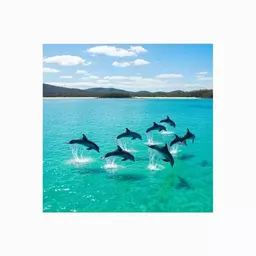Sustainable Travel Tips for Jervis Bay

The journey to Jervis Bay is not just about breathtaking beaches and stunning wildlife; it's also about the choices we make as travelers. As you plan your visit, consider how your actions can help preserve this paradise for generations to come. Are you ready to explore sustainable travel practices that not only enhance your experience but also protect the environment?
What You Will Learn
- The importance of making eco-friendly travel choices to protect Jervis Bay's natural beauty and cultural heritage.
- Practical tips for minimizing waste and conserving energy while traveling, such as using reusable items and supporting local businesses.
- Best times to visit for wildlife observation, including dolphin and whale watching seasons for unforgettable experiences.
- Key practices to respect local ecosystems, such as sticking to designated paths and observing wildlife from a distance.
- Effective strategies for offsetting your carbon footprint during your trip, including choosing eco-friendly transportation options.
- Opportunities to engage in local conservation initiatives, from volunteering at wildlife sanctuaries to participating in beach clean-ups.
Key Eco-Friendly Travel Practices for Jervis Bay
Embracing eco-friendly travel habits can significantly enhance the sustainability of your visit to Jervis Bay. Below are essential practices to consider:
Use Reusable Items
Instead of single-use plastics, pack items like reusable water bottles and shopping bags to minimize waste.
Conserve Energy
Turn off lights and unplug devices in your accommodation to save energy and reduce your carbon footprint.
Support Local Businesses
Choose to dine at local restaurants and shop at nearby stores to promote the local economy.
Practice Leave No Trace
Ensure that you leave the natural environment as you found it, by taking all your trash with you.
Understanding Sustainable Travel in Jervis Bay
When we think about visiting beautiful places like Jervis Bay, it's essential to consider how our travel choices impact the environment. Sustainable travel means making decisions that protect the stunning landscapes and vibrant wildlife that make Jervis Bay so special. For me, it’s about enjoying the breathtaking beaches while ensuring they remain pristine for future visitors to enjoy. So, what are some ways we can travel responsibly?
One of the most important aspects of eco-friendly travel practices is recognizing our role in preserving nature. By adopting sustainable habits, we can reduce our carbon footprint and contribute to the well-being of local communities. Simple actions like minimizing waste and respecting wildlife habitats can make a big difference. Next time you plan a trip, ask yourself how you can travel in harmony with nature!
The Importance of Eco-Friendly Travel Practices
In Jervis Bay, eco-friendly travel practices are crucial for maintaining the area's natural beauty and cultural heritage. These practices help protect local ecosystems, ensuring that the unique flora and fauna thrive. Plus, they support local economies by promoting sustainable tourism efforts. Here are some key eco-friendly travel practices to consider:
- Use reusable items: Instead of single-use plastics, pack items like reusable water bottles and shopping bags.
- Conserve energy: Turn off lights and unplug devices in your accommodation to save energy.
- Support local businesses: Choose to dine at local restaurants and shop at nearby stores to help boost the community.
- Practice Leave No Trace: Ensure that you leave the natural environment as you found it, taking all your trash with you.
By incorporating these practices into your travel plans, you'll not only enjoy your time in Jervis Bay but also contribute positively to its preservation!
Overview of Jervis Bay’s Natural and Cultural Significance
Did you know that Jervis Bay is home to some of the most stunning beaches in Australia? The area boasts crystal-clear waters, diverse marine life, and lush landscapes that are a delight for nature lovers. It's essential to recognize the cultural significance of this region as well, particularly its role as a protected area within the Jervis Bay National Park. Jervis Bay holds deep connections with the Indigenous communities, and respecting their history and traditions is vital.
Discovering Jervis Bay means experiencing its incredible natural and cultural heritage. Here are some highlights that showcase why this destination is so special:
- Pristine beaches: Hyams Beach, famous for its white sands, invites visitors to relax and soak up the sun.
- Diverse wildlife: Keep an eye out for dolphins, seals, and an array of bird species while exploring the area. For more information on its rich biodiversity, you can visit the Booderee National Park website.
- Cultural experiences: Engage with local Indigenous communities to learn about their traditions and connection to the land.
- Protected parks: Booderee National Park offers stunning landscapes and opportunities for hiking and wildlife spotting, as detailed on Wikipedia's entry for Jervis Bay National Park.
As you explore Jervis Bay, take a moment to appreciate its remarkable natural beauty and the rich cultural heritage that deserves our respect and preservation. Let's work together to ensure that this incredible destination remains a cherished place for generations to come!
Pro Tip
When visiting Jervis Bay, consider using an eco-friendly app to track your carbon footprint while traveling. Many apps can help you make informed decisions about transportation, accommodations, and activities that support sustainability. This not only enhances your travel experience but also empowers you to make a positive impact on the environment.
Seasonal Considerations for Sustainable Travel
When planning your trip to Jervis Bay, it's essential to consider the seasons. Each time of year brings different wildlife sightings and natural wonders. Understanding the seasonal patterns will enhance your experience and help you plan the perfect visit. Have you ever thought about how the changing seasons can affect your adventures? Let's explore the best times to visit and what to expect!
Best Times to Visit Jervis Bay for Wildlife Observation
Jervis Bay is renowned for its rich biodiversity, and timing your visit can lead to incredible wildlife encounters. Many travelers are eager to see the local dolphins and whales. Here are some of the best times to observe them:
- Dolphin Watching: All year round, but particularly active in spring and summer.
- Whale Migration: From June to November, you can witness the majestic humpback whales passing by.
- Bird Watching: Autumn is perfect for spotting migratory birds in the region.
By aligning your visit with these seasons, you’ll not only enjoy the sights but also contribute to responsible wildlife observation practices. After all, the thrill of watching these magnificent creatures in their natural habitat is an experience you won’t forget!
Respecting Local Ecosystems Throughout the Year
Every season has its own unique beauty in Jervis Bay, and each ecosystem deserves our respect. Engaging in sustainable travel practices helps protect these precious environments. Here are some simple ways to show your commitment to preserving Jervis Bay:
- Stay on Designated Paths: Protect delicate ecosystems by following marked trails.
- Avoid Disturbing Wildlife: Observe from a distance to minimize stress on animals.
- Practice Responsible Photography: No flash photography or intruding into their space.
As you enjoy the breathtaking scenery, remember that each step you take can make a difference. By being mindful of local ecosystems, you contribute to a sustainable future for Jervis Bay.
Understanding Seasonal Travel and Its Impact on Wildlife
Traveling during specific seasons can greatly affect wildlife behavior and habitat health. For instance, visiting during the breeding season can impact animal populations if not done responsibly. Here are a few considerations to keep in mind:
- Breeding Seasons: Be aware of when animals are mating or nesting to avoid disturbing them.
- Migration Patterns: Timing your visit with migration seasons can enhance your wildlife experience.
- Seasonal Closures: Some areas may be closed during certain times to protect sensitive habitats.
Understanding these factors allows travelers to engage with nature thoughtfully and responsibly. At Discover Jervis Bay, we emphasize the importance of traveling with an eco-conscious mindset, ensuring the beauty of our coastal paradise is preserved for years to come!
Joining the Conversation on Conservation
As travelers, we have the power to make a positive impact on the places we visit. Joining the conversation about conservation in Jervis Bay can enhance your travel experience while contributing to the local ecosystem. Are you ready to take action? Let’s explore how you can offset your carbon footprint and engage with the community!
How to Offset Your Carbon Footprint While Visiting Jervis Bay
Offsetting your carbon footprint is easier than you might think! Here are some effective strategies to consider:
- Choose Eco-Friendly Transportation: Opt for public transport or carpooling when possible.
- Support Local Carbon Offset Projects: Invest in local initiatives that plant trees or restore habitats.
- Reduce Energy Use: Unplug devices and turn off lights in your accommodation when not in use.
Every little action counts! By incorporating these tips, you can enjoy all that Jervis Bay has to offer while minimizing your environmental impact.
Engaging in Local Conservation Initiatives and Volunteer Opportunities
Getting involved with local conservation efforts is a fulfilling way to connect with the community and the environment. Here are some initiatives you might want to consider:
- Join Local Conservation Groups: Participate in regular clean-up events and restoration projects.
- Volunteer at Wildlife Sanctuaries: Help care for injured or orphaned wildlife.
- Educational Workshops: Attend sessions to learn more about local ecosystems and conservation methods.
By volunteering, you not only support the local environment but also gain a deeper appreciation for Jervis Bay's natural wonders. Plus, you'll meet like-minded travelers and locals who share your passion for sustainability!
Participating in Beach Clean-Ups and Environmental Education
One of the most impactful ways to give back to Jervis Bay is by participating in beach clean-ups. Not only do these events keep our beautiful beaches pristine, but they also create awareness about the importance of protecting our oceans. Here’s how you can participate:
- Sign Up for Scheduled Clean-Ups: Check local organizations like the Jervis Bay Marine Park for upcoming events.
- Organize Your Own Clean-Up: Gather friends and family for a fun, eco-friendly activity!
- Spread Awareness: Share your experiences on social media to inspire others!
Participating in these initiatives is not just rewarding; it enhances your connection to the stunning environment that Jervis Bay has to offer. Together, we can make a difference!
Frequently Asked Questions About Sustainable Travel in Jervis Bay
- What is sustainable travel in Jervis Bay?
- Sustainable travel in Jervis Bay involves making eco-conscious choices to protect the area's natural beauty and cultural heritage, ensuring it remains pristine for future generations. This includes minimizing waste, conserving energy, and supporting local communities.
- How can I minimize my environmental impact while visiting Jervis Bay?
- You can minimize your environmental impact by using reusable items (like water bottles and shopping bags), conserving energy in your accommodation, supporting local businesses, and practicing Leave No Trace principles by taking all your trash with you.
- When is the best time to visit Jervis Bay for wildlife observation?
- Dolphins can be seen year-round, with peak activity in spring and summer. Whale migration season runs from June to November, offering opportunities to spot humpback whales. Autumn is ideal for bird watching.
- How can I respect local ecosystems in Jervis Bay?
- Always stay on designated paths, observe wildlife from a distance to avoid disturbance, and practice responsible photography without using flash or intruding on animals' space. Be mindful of breeding seasons and seasonal closures in sensitive habitats.
- Are there opportunities to get involved in local conservation efforts?
- Yes, you can join local conservation groups, volunteer at wildlife sanctuaries, attend educational workshops, or participate in beach clean-ups organized by local organizations like the Jervis Bay Marine Park.
Recap of Sustainable Travel Practices for Jervis Bay
As we wrap up this exploration of sustainable travel in Jervis Bay, let's take a moment to reflect on the key points. By being mindful of our actions, we can ensure our visits have a positive impact on this beautiful region. Here are some key takeaways:
- Plan your trip around wildlife observation seasons to enhance your experience.
- Engage in eco-friendly practices and support local conservation efforts.
- Participate in community initiatives and respect local ecosystems.
Are you ready to embark on a journey filled with adventure and mindfulness? Remember to book responsibly and always show respect for nature. After all, it’s our collective responsibility to protect the incredible beauty of Jervis Bay for future generations to enjoy!
Recap of Key Points
Here is a quick recap of the important points discussed in the article:
- Practice eco-friendly travel by using reusable items, conserving energy, and supporting local businesses.
- Respect local ecosystems by staying on designated paths and avoiding disturbances to wildlife.
- Plan your visit around wildlife observation seasons for the best experiences.
- Engage in local conservation initiatives and participate in community efforts like beach clean-ups.
- Offset your carbon footprint by choosing eco-friendly transportation and supporting local environmental projects.









